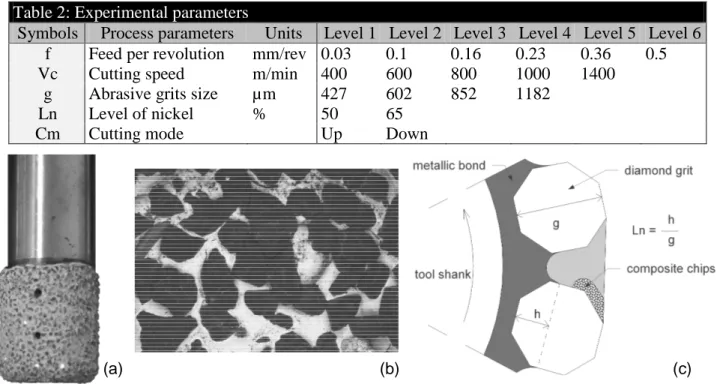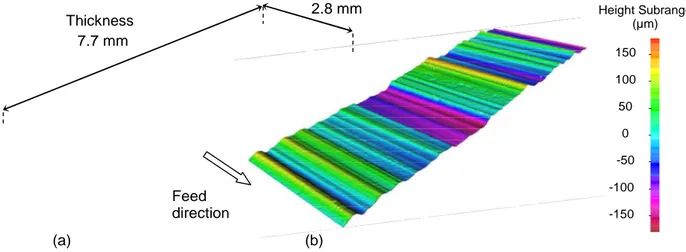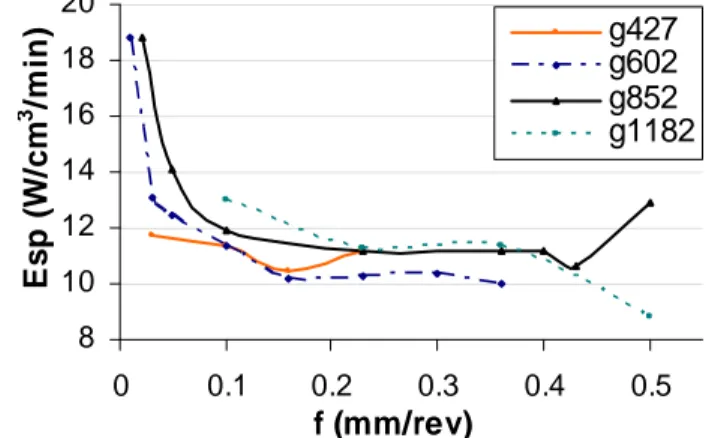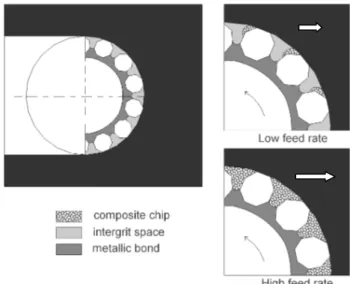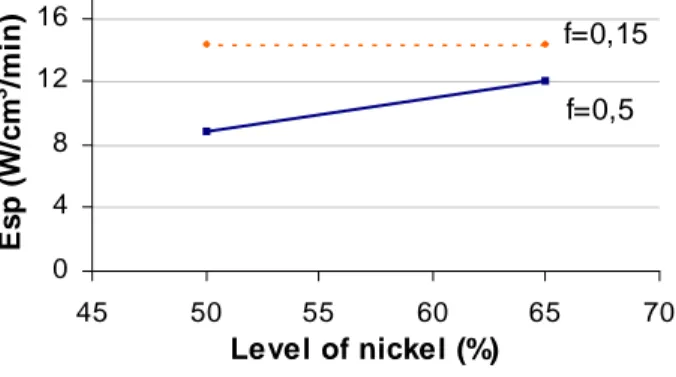HAL Id: hal-00862205
https://hal.archives-ouvertes.fr/hal-00862205
Submitted on 16 Sep 2013HAL is a multi-disciplinary open access archive for the deposit and dissemination of sci-entific research documents, whether they are pub-lished or not. The documents may come from teaching and research institutions in France or abroad, or from public or private research centers.
L’archive ouverte pluridisciplinaire HAL, est destinée au dépôt et à la diffusion de documents scientifiques de niveau recherche, publiés ou non, émanant des établissements d’enseignement et de recherche français ou étrangers, des laboratoires publics ou privés.
Optimization of Process Parameters in CFRP
Machining with Diamond Abrasive Cutters
Aude Boudelier, Mathieu Ritou, Sébastien Garnier, Benoît Furet
To cite this version:
Aude Boudelier, Mathieu Ritou, Sébastien Garnier, Benoît Furet. Optimization of Process Parameters in CFRP Machining with Diamond Abrasive Cutters. Advanced Materials Research, Trans Tech Publications, 2011, 223, pp.774-783. �10.4028/www.scientific.net/AMR.223.774�. �hal-00862205�
Optimization of Process Parameters in CFRP Machining
with Diamond Abrasive Cutters
Aude BOUDELIER, Mathieu RITOU, Sebastien GARNIER, Benoit FURET
IRCCyN - UMR CNRS 65971 rue de la Noë, 44321 Nantes, FRANCE
aude.boudelier@irccyn.ec-nantes.fr, mathieu.ritou@irccyn.ec-nantes.fr, sebastien.garnier@irccyn.ec-nantes.fr, benoit.furet@irccyn.ec-nantes.fr
Keywords: CFRP laminate composite; trimming; diamond abrasive cutter; surface roughness;
cutting mechanism; productivity.
Abstract. The present paper proposes a methodology to optimize process parameters for trimming applications with diamond abrasive cutters.
This methodology is based on the study of quality of trimmed surface, through material integrity and surface roughness, and on the study of cutting mechanisms. Their evolutions according to tool parameters and cutting conditions have been analysed. Results show that diamond grits size must be chosen according to the required surface roughness. Feedrate must respect cutting limitations due to CFRP removal mechanisms with abrasive cutters, which have been identify through analyses of specific cutting energy.
Finally, a protocol in two steps is proposed to determine the optimum process parameters according to the application. Firstly, constraint functions due to respect of quality and to limiting cutting phenomena are defined. Thus, limiting values of process parameters are determined. Then, process parameters are selected in order to optimize productivity.
Introduction
Machining of laminate composite materials mainly consists in surface finishing operations, like drilling and trimming, so as to achieve dimensional tolerances and surface quality required by technical specifications. These operations are often difficult due to composite mechanical and thermal properties: heterogeneity, anisotropy and low thermal conductivity [1,2]. Moreover, its high abrasiveness conducts to excessive tool wear [3]. That is why carbide tools and PCD (Poly Crystalline Diamond) endmills are not adapted to CFRP trimming [1], even if they generate interesting surface roughness. Moreover, PCD costs are significant and they are excessively brittle [4]. That is why tools constituted of diamond grits, like discs and diamond abrasive cutters, have been specifically developed for CFRP trimming operations. Tool life and productivity are improved and costs are reduced. Generally, tool life of diamond abrasive cutters is about 10 times more important than PCD tool [5].
Few works have been published about trimming operations with diamond abrasive cutters, especially with high grits size. Concerning quality of the trimmed surface, only influence of grits size and feedrate on profile roughness has been considered using R-parameters [6], as usually in metallic parts. Besides, the required value is set empirically and low levels are often specified when contact or tightness functions are needed. The same values are usually kept for the specification of composite workpieces even if functional requirements are different: surface roughness criteria and their level must be adapted to more tolerant levels. Concerning productivity aspect, Colligan et al. [6] have performed preliminary tests to study cutter forces. However, there is no research concerning performances of diamond abrasive cutters, depending on process parameters. Therefore, it is difficult to correctly choice them depending on the trimming application.
Different approaches have been proposed to help operators in order to perform the choice of process parameters. Some of them focus mainly on the definition of cutting conditions (cutting speed, feedrate, depth of cut…) like the methods of tool-work material pair [COM - 7]. This method is based on the study of cutting mechanisms through forces measurements. Currently, it is only applicable in the domain of metallic materials machining. Moreover, during the phase of parameters choice, quality criteria of machined surface are not taken into account. Other approaches consist in selecting automatically both tool geometry and associated cutting conditions. They are often based on an expert system [8,9]. In these methods, quality criteria are often assimilated to constraints. However, they mainly focus on turning applications in metallic work pieces.
In this paper, a methodology that leads to the optimization of process parameters for composite trimming applications with diamond abrasive cutters is built. In the first part, this methodology based on the quality of trimmed surface and on the cutting mechanisms is presented. In order to apply it, authors have carried out experiments in order to analyse influence of five parameters: feed per revolution, cutting speed, cutting mode, abrasive grits size and grits setting on tool body. It conducts to the definition of a protocol that leads to choice process parameters. This protocol considers the definition of constraint functions due to the required quality and to limiting cutting phenomena observed during experiments. Moreover, it optimizes process productivity.
Methodology
The methodology proposed to optimize the process parameters for trimming operations with diamond abrasive cutters. It consists of two successive steps.
The first one is based on the quality of trimmed surface. Tool and process parameters have firstly to be chosen in order to respect the required quality, specified in the technical specifications. As many sorts of defects, characteristic of composites materials, can occur during machining operations [10], two categories of specific quality criteria have been considered: material integrity, including thermal damage and different types of delamination, and surface roughness. During this stage, limits of process parameters and their influence on quality criteria are analysed.
The second step which is proposed consists in studying the cutting mechanisms which are observed during trimming operations. Firstly, objective is to detect eventual limiting cutting phenomena, identified through analyses of specific cutting energy (Esp), obtained from spindle power measurements. Then, it aims at defining the influence of process parameters.
Considering results of the two previous stages, a protocol in two steps is proposed to optimize process parameters according to the application. Firstly, constraint functions due to respect of quality and to limiting cutting phenomena are defined. Thus, limiting values of process parameters are determined. Then, they are selected in order to optimize productivity. Finally, practical recommendations concerning the choice of tools parameters and cutting conditions are given.
Experimental Procedure Material and Tools
Trimming tests were performed in a 9.1 mm thick laminate composite, made with thermosetting matrix. It was composed of 35 plies of unidirectional graphite fibre fabric, oriented in different direction (Table 1).
Different diamond abrasive cutters, manufactured by Asahi Diamond and AOB, were used. All were composed of natural diamond grits fixed with a nickel bond on a cylindrical body by electro deposition (Fig 1a, b). Four diamond abrasive grits sizes and two tools diameters were tested (Table 2). Two levels of nickel (Ln), defined as the rate of grits contained in the bond, were also used (Fig 1c).
Table 1: Mechanical properties of T800-M21
Number of plies 35 Ply thickness 0.26 mm Fibre volume fraction 56.6 % Laminate Density 1580 kg/m3 Compression mod. 136 GPa Tensile mod. 172 GPa
Layup (0/-45/90/90/45/90/90/45/0/-45/ 90/90/90/45/90/-45/90/45)2s
Table 2: Experimental parameters
Symbols Process parameters Units Level 1 Level 2 Level 3 Level 4 Level 5 Level 6 f Feed per revolution mm/rev 0.03 0.1 0.16 0.23 0.36 0.5 Vc Cutting speed m/min 400 600 800 1000 1400
g Abrasive grits size µm 427 602 852 1182 Ln Level of nickel % 50 65
Cm Cutting mode Up Down
(a) (b)
a
(c)
a
Figure 1: Diamond abrasive cutter (a), observed on SEM (b), Tools parameters definition(c).
Machining tests
Trimming tests were carried out on a three-axis Huron KX30 milling machine, equipped with a 28000 RPM - 40 kW spindle. External and internal water-based coolant was used. A 9.1 mm depth of cut corresponding to part thickness and a width of cut corresponding to tool diameter were used, as usual in rough trimming (Fig 2). During tests, a constant feedrate direction in relation to fibre orientation was considered (parallel to 0° external ply).
Figure 2: Experimental set-up.
Cutting conditions were studied through feed per revolution and cutting speed. Six feedrates and four cutting speeds, defined in Table 2, were tested during experiments. In order to reduce the number of experiments and to study a large range of values, tests were separated in three
full-factorial experiments. In total, 88 trial cuts were machined. Each one measured 70 mm length. In order to determine effects and interactions significances of different parameters, analyses of variance (ANOVA) with a 95% confidence level, are carried out.
Measuring procedures
Concerning quality measurements, two criteria were studied. Visual inspections were performed to detect material integrity defects and surface roughness measurements were carried out with an optical measurements system, based on Focus-Variation. An S-filter frequency of 80 µm was used, corresponding to four times the ply thickness, ensuring a correct description of each ply. Zones of 2.8*8 mm in transverse direction were chosen to carry out measurements. Because of surface damages, measurements were taken between 0.5 mm below the top surface and 0.5 mm above the bottom surface. Moreover, three measures were carried out for each sample in order to check the results variability. The average of these values is analysed.
In order to identify possible limiting phenomena, power measurements were performed. It was obtained with a power transducer WattPilote, integrated into the machine. Cutting forces were measured using a 9255B Kistler quartz three-component dynamometer, mounted between the work piece and the table of the machining centre. Contrary to endmills, diamond abrasive cutters lead to constant cutting forces during cuts. So, for each run, average values of feed force Ff and normal force Fn (Fig 2) are evaluated. Then, resultant of cutting forces F is calculated. In order to analyse cutting mechanisms, Esp is calculated from the following power model:
P = Esp.ae.ap.f.N (1) where P is the cutting power (W), Esp the specific cutting energy (W/mm3/min), ap and ae the depth and width of cut (mm), f the feed per revolution (mm/rev) and N the rotational speed (rev/min). This experimental model has been previously validated in CFRP trimming with diamond abrasive cutter. In this paper, only Esp results are shown because cutting forces trends are similar.
Quality of trimmed surfaces Material integrity
Concerning material integrity, defects can occur in two different area of the trimmed surface: on the surface plies corresponding to outer defects, or on the subsurface plies corresponding to inner defects (Fig 3). (c) (b) Type 2 Type 1 (a) Surface plies Subsurface plies
Figure 3: Illustration of (a) Type 1 and Type 2 outer delamination, (b) Type 1 inner delamination and (c) Type 2 inner delamination.
Generally, most of defects occur on outer layers because they are not held by neighbouring layers. Whatever their position, two main delamination defects exist: Type 1 and Type 2 (Fig 3a).
They have been documented by Colligan et al. [2]. Type 1 delamination in surface plies, also called flaking, consists of areas where ply fibres are missing or peeling due to the nature of higher ply weaving and operating conditions. On the contrary, Type 2 delamination consists of fibres which are not neatly cut and exceed the trimmed contour (Fig 3a).
Concerning subsurface plies, Type 1 delamination is defined as a cohesion defect between at least two plies. Generally, they are dissociated because of too high level of axial forces (Fig 3b). Type 2 inner delamination is similar to Type 2 outer delamination: uncut fibres in inner ply (Fig 3c). During experiments, minor defects of material integrity occur, both in terms of number and dimensions. None had visual marks of thermal damage after machining and no surface delamination was detected. Consequently, no tool parameters and cutting conditions were found to be significant on delamination defects. That is why diamond abrasive cutters are very interesting tools in order to respect integrity of trimmed materials.
Surface roughness
Sa-parameter (arithmetical mean height of the surface [11]) has been chosen to study the influence of tool parameters and cutting conditions on roughness of the laminate trimmed surfaces. Indeed, a preliminary study shows that areal parameters were more relevant to characterize them. In longitudinal direction (parallel to the plies), measures is performed only on one ply, so orientation of fibres is constant. Therefore, roughness profile is representative of height between different fibres. On the contrary, in transverse direction (part thickness), measures are performed on several plies. So, roughness profile is representative of height differences between plies. As cutting mechanisms are different according to fibres orientation, transverse roughness is more important than longitudinal one. It results that roughness and waviness parameters evaluated from profile highly depend on the measurement direction. Consequently, areal parameter was chosen in order to consider all measurement directions.
The predominant factor influencing Sa-parameter is grits size. Sa significantly increases when grits size increases (Fig 4, 5a). Indeed, each grit that contribute to the machining creates a mark in the trimmed surface. Therefore, dimensions of this mark depend mainly on grits size. That is why grits size must be chosen according to the surface roughness requirements. Moreover, checking tools before machining is important. Indeed, impact of the grits quality on the generated surface is very important. Despite their low cost, a minimum level of tool quality is necessary.
Figure 4: Surface topology after machining with grits size of (a) 427 µm and (b) 852 µm. Even if its effect is limited, feed per revolution is also significant on Sa (Fig 5b). The higher the feedrate is, the better the Sa is. Additional analyses show that profile in longitudinal direction was not impacted by the evolution of feed (Figure 4); it can not be compared with endmills applications in metallic material where surface roughness depends essentially on feed. Analyses show that Sa
Height Subrange (µm) 150 100 50 0 -50 -100 -150 Feed direction 7.7 mm 2.8 mm (a) (b) Thickness
variation is essentially due to evolution of profile along transversal directions (Figure 4). During experiments, tools break-in was observed since new diamond abrasive cutters were used. Analyses of trimmed profile confirm that the evolution of Sa is mainly due either to pull out of grits from the nickel bond or to cleavage of grits faces. Consequently, statistical repartition of grits altitude is better and Sa is improved.
0 10 20 30 40 50 60 70 0 500 1000 1500 Grits size (µm) S a ( µ m ) f0.1 Vc800 dw f0.1 Vc1400 dw f0.23 Vc800 dw f0.23 Vc1400 dw (a) 0 10 20 30 40 50 60 70 0 0.2 0.4 0.6 f (mm/rev) S a ( µ m ) Vc800 up Vc800 dw Vc1400 up Vc1400 dw G852 (b) 0 10 20 30 40 50 60 70 0 500 1000 1500 Vc (m/min) S a ( µ m ) f0.1 dw f0.23 dw f0.1 up f0.23 up G852 (c)
Figure 5: Influence of (a) grits size, (b) feedrate, (c) cutting speed and cutting mode on Sa areal parameter.
In the present study, no significant trend is observed with evolution of cutting speed and cutting mode (Fig 5c). They are considered as not influent on surface roughness. Consequently, either down milling or up milling can be chosen. Concerning choice of cutting speed, cautions must be taken in order to check that glass transition temperature is not reached in order to avoid matrix burn.
Study of cutting mechanisms
Second step of our methodology proposed to study the cutting mechanisms which are observed during trimming operations. Different process parameters are tested and their influence is observed. Finally, limiting cutting phenomena are identified through analyses of specific cutting energy.
Choice of cutting speed
No limiting phenomenon is observed when spindle speed is maximised. Moreover, results show that increase of cutting speed is favourable to cutting mechanism (Fig 6). Indeed, local temperature of trimmed surface increases when cutting speed rises. Xiao and al. [12] have observed this phenomenon in orthogonal cutting of thermosetting materials. The higher the temperature is, the more important the mobility of molecular chains is. Consequently, mechanical properties of the material are affected and chips removal becomes easier. In this way, Esp decreases.
0 4 8 12 16 20 0 400 800 1200 1600
Cutting speed (m/min)
E s p ( W /c m 3 /m in ) g 427 g 602 g 852 g 1182
Figure 6: Effect of cutting speed on Esp (f=0.1 mm/rev).
Limiting cutting phenomena due to feedrate
Concerning feed per revolution, limiting phenomena were observed at extreme values of studied range (Fig 7). 8 10 12 14 16 18 20 0 0.1 0.2 0.3 0.4 0.5 f (mm/rev) E s p ( W /c m 3 /m in ) g427 g602 g852 g1182
Figure 7: Influence of feed per revolution and grits size on Esp.
Cutting mechanism limit at low feedrate
Esp greatly increases under a given threshold of feed (Fig 7). The larger the grits size is, the higher the threshold value is. Figure 7 shows that 602 µm and 852 µm grits sizes have reached this critical threshold. Lower feed per revolution should have been tested in order to observe similar phenomenon on the other tools.
The lower the feedrate is, the smaller the chip thickness is. Consequently, Esp necessary to remove material rises because other mechanisms than cutting must be considered. Rubbing phenomenon between grit cutting face and workpiece occurred. Mondelin et al. [13] have also noted that phenomenon during scratching tests on the same material. Since diamond grits shapes are irregular and their average rake angle is highly negative, important friction between tool and part occurs and energy is dissipated without cutting. Similar cases were also observed in steel grinding applications [14]. Even if materials are different, some analogies can be made: there is a minimum chip under which cut does not occur in good conditions.
Cutting mechanism limit at high feedrate
Presence of a second limiting phenomenon is noticed in Figure 7, especially for 427 and 852 grits sizes. When feed per revolution reaches a critical threshold, respectively 0.16 mm/rev and 0.36 mm/rev for grits size of 427 and 852 µm, Esp quickly increases. Tools reach their saturation limit, depending on their grits size. On the contrary, tool loading has not occurred for 602 and 1182 µm grits because feed per revolution chosen for the experiment was too low.
Loading of diamond abrasive cutter explains this Esp rise. Same phenomena have been documented for metal grinding application with wheels [14]. When diamond abrasive cutters machine, chips are accumulated in the intergrit space (Fig 8). They are composed of small CFRP aggregates. If feed per revolution is too important, chips do not have enough space between grits to lodge before being evacuated. Mechanism of cut is deteriorated and Esp increases.
Figure 8: Intergrit space saturation.
This limit of chip removal is reached earlier with small grits size. Indeed, the smaller the grit size is, the lower the intergrit space is, because of higher grits density (Fig 9, obtained from tools scanning). 0 30 60 90 120 150 180 200 400 600 800 1000 1200 Grits size (µm) In te rg ri t s p a c e ( m m 3 )
Figure 9: Estimation of intergrit space.
Consequently, feed must be chosen considering grits size, and especially intergrit space in order to avoid tool saturation. Considering our experimental results, the maximum feed per revolution can be set at 50 to 60% of grit size. This value depends also on other factors such as material bulking.
Influence of level of nickel
In order to improve productivity criteria, it’s better to use a low level of nickel. Indeed, at high feedrate, Esp increases when level of nickel increases (Fig 10). The lower the level of nickel is, the larger the intergrit space is. Consequently, saturation is reached later with small level of nickel, and feed per revolution can be potentially more important. Nevertheless, it has to be large enough in order to hold grits despite cutting forces. It is a compromise between mechanical strength of tool and productivity. Limits concerning tools manufacturing must also be taken into account. Indeed,
the level of nickel is difficult to control during tool manufacturing process. So, an average value of 50% is suitable. f=0,15 f=0,5 0 4 8 12 16 45 50 55 60 65 70 Level of nickel (%) E s p ( W /c m 3 /m in )
Figure 10: Influence of level of nickel on Esp.
Protocol of Process Parameters Optimization
In the previous part, a methodology based on the respect of quality of trimmed surface and on the analyse of cutting mechanisms has been applied. Their evolutions according to tool parameters and cutting conditions have been studied. Results permits to design a protocol which leads to an optimization of process parameters using diamond abrasive cutters, according to the trimming application. This protocol consists of two successive steps.
Firstly, constraint functions due to respect of quality, through material integrity and surface roughness, and to limiting cutting phenomena are identified. Thus, limiting values of process parameters are determined and domain of definition for each parameter is specified:
1. Maximum size of diamond grits is limited by the required surface roughness. Indeed, surface roughness depends mainly on grits sizes because they create marks on trimmed surface.
2. It has been found that no cutting mechanism limits cutting speed in the considered range. Moreover, it has no effect on quality criteria. That is why maximum cutting speed is just limited by available spindle speed.
3. Feed per revolution imposes the dimension of created chip. There is a minimum chip, and consequently a minimum feedrate, under which cut does not occur in good conditions. Indeed, non-cutting phenomena like ploughing and friction between grit cutting face and workpiece get the upper hand. On the opposite, there is a maximum feedrate which must also not be exceeded in order to avoid tool intergrit space saturation. This threshold depends on grits size and materials. In T800 M21, it is estimated at about 50 to 60% of grits size. In other application, with different materials, this value must be adapted. Esp analyse, via power acquisition during machining, would permit to find the optimized feed per revolution value.
4. There is a maximum level of nickel above which saturation of intergrit space occurs. This limit depends also on feed per revolution. On the opposition, level of nickel must be large enough in order to hold grits despite cutting forces. Limits concerning tools manufacturing must also be taken into account (50% to 70% of grits size).
5. No limitation concerns the choice of cutting mode. Indeed, material integrity is always respected, surface roughness does not depend on it, and no limiting cutting phenomenon was observed.
The second step of this protocol consists in selecting process parameters in the previously defined domain in order to optimize productivity, through the Surfacic Material Removal Rate. It leads to the following protocol concerning the choice of suitable tool and process parameters:
1. High feed per revolution must be favoured to improve productivity.
2. Important grits size and low level of nickel permit to increase limit of tool saturation because intergrit space is larger. Consequently, feedrate can be increased and productivity is improved.
That is why high grits size and low level of nickel are advised, within the respect of surface roughness.
3. High cutting speed increases productivity. Moreover, it improves cutting mechanism because of thermal effects in CFRP material. As it has no influence on quality criteria, the highest cutting speed, i.e. maximum spindle speed, is recommended.
Conclusion
The present paper proposes a methodology which leads to the optimization of process parameters during trimming operations of composite material. It is based on the respect of quality, considering material integrity and surface roughness, and on the study of limiting cutting phenomena. Their evolutions according to tool parameters and cutting conditions are analysed. The whole results lead to a protocol in two steps in order to optimize process parameters during trimming applications. Firstly, constraint functions due to respect of quality and to limiting cutting phenomena are identified. It determines the domain of definition of each process parameters. Then, process parameters are selected in this domain in order to optimize productivity.
The proposed methodology has been applied in composite trimming application with diamond abrasive cutter. Results show that they are relevant tool in order to avoid delamination defects. Grit size and feed per revolution are also key factors to assure required surface roughness and improve productivity, respectively. A protocol has also been defined in order to determine adapted tool parameters and cutting conditions in these trimming applications with diamond abrasive cutters.
References
[1] R. Teti: CIRP Annals - Manufacturing Technology Vol. 51 (2002), p. 611-634. [2] K. Collingan and M. Ramulu: Manufacturing Review Vol. 5 (1992), p. 274-283.
[3] B. Furet, D. Le Borgne and B. Jolivel, JEC Composites Magazine Vol. 18 (2005), p. 41-44. [4] J. Sheikh-Ahmad, in: Machining of Polymer Composites, edited by Springer (2009).
[5] Information on http://ugv-alu-composites.com, Project UGV Aluminium/Composites (2010). [6] K. Collingan: Journal of Manufacturing Science and Engineering Vol. 151 (1999), p. 647-655. [7] Norme AFNOR NF E 66-520, 1994, Couple Outil-Matière : Domaine de Fonctionnement des Outils Coupants.
[8] B. Arezoo, K. Ridgway and A.M.A. Al-Ahmari: Computers in Industry Vol. 42 (2000), p. 43-58.
[9] L. Mathieu, P. Bourdet and F. Le Maître: Annals of the CIRP 36 (1987), p. 347-350.
[10] N.S. Hu and L.C. Zhang: Journal of Materials Processing Technology Vol. 152 (2004), p. 333-338.
[11] ISO 25178, Geometrical Product Specifications (GPS) - Surface texture: Areal - Terms, definitions and surface texture parameters.
[12] K.Q. Xiao and L.C. Zhang: International Journal of Mechanical Sciences Vol.44 (2002), p. 2317-2336.
[13] A. Mondelin, B. Furet and J. Rech: Tribology International Vol. 43 (2010), p. 1665-1673. [14] S. Ghosh, A.B. Chattopadhyay and S. Paul, International Journal of Machine Tools and
